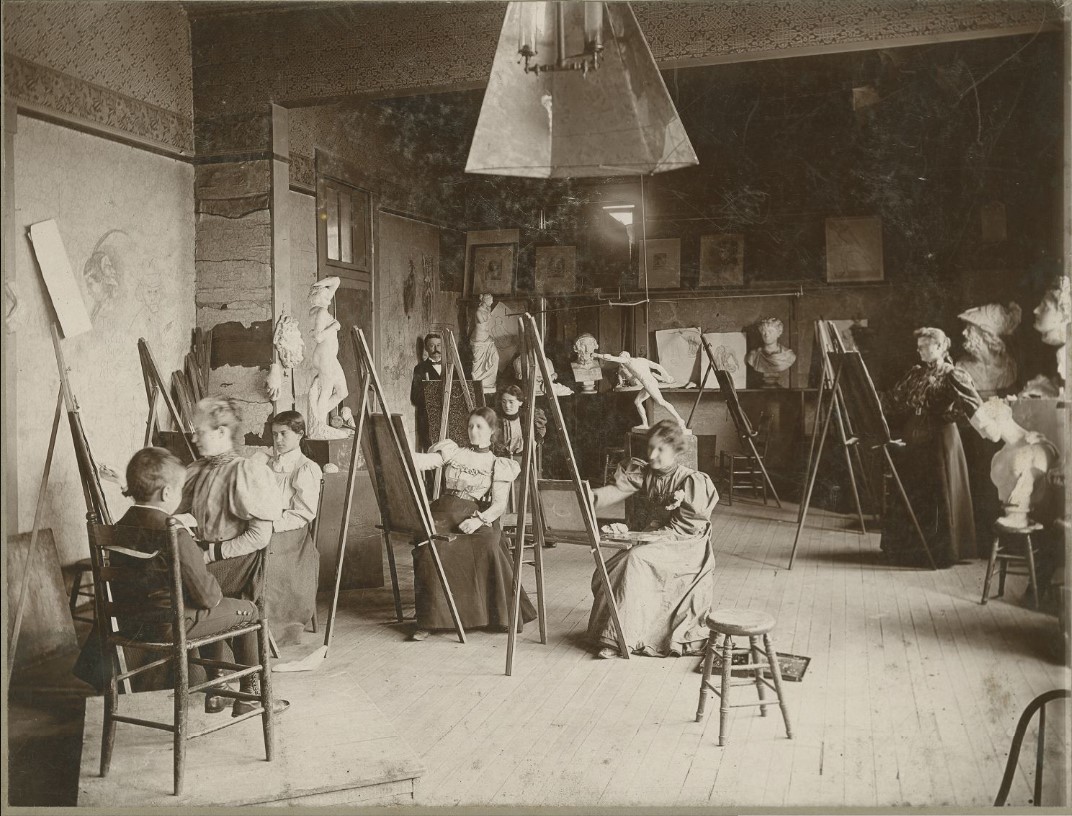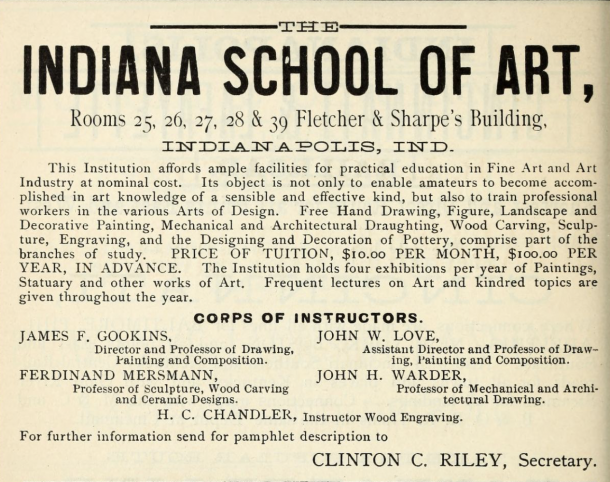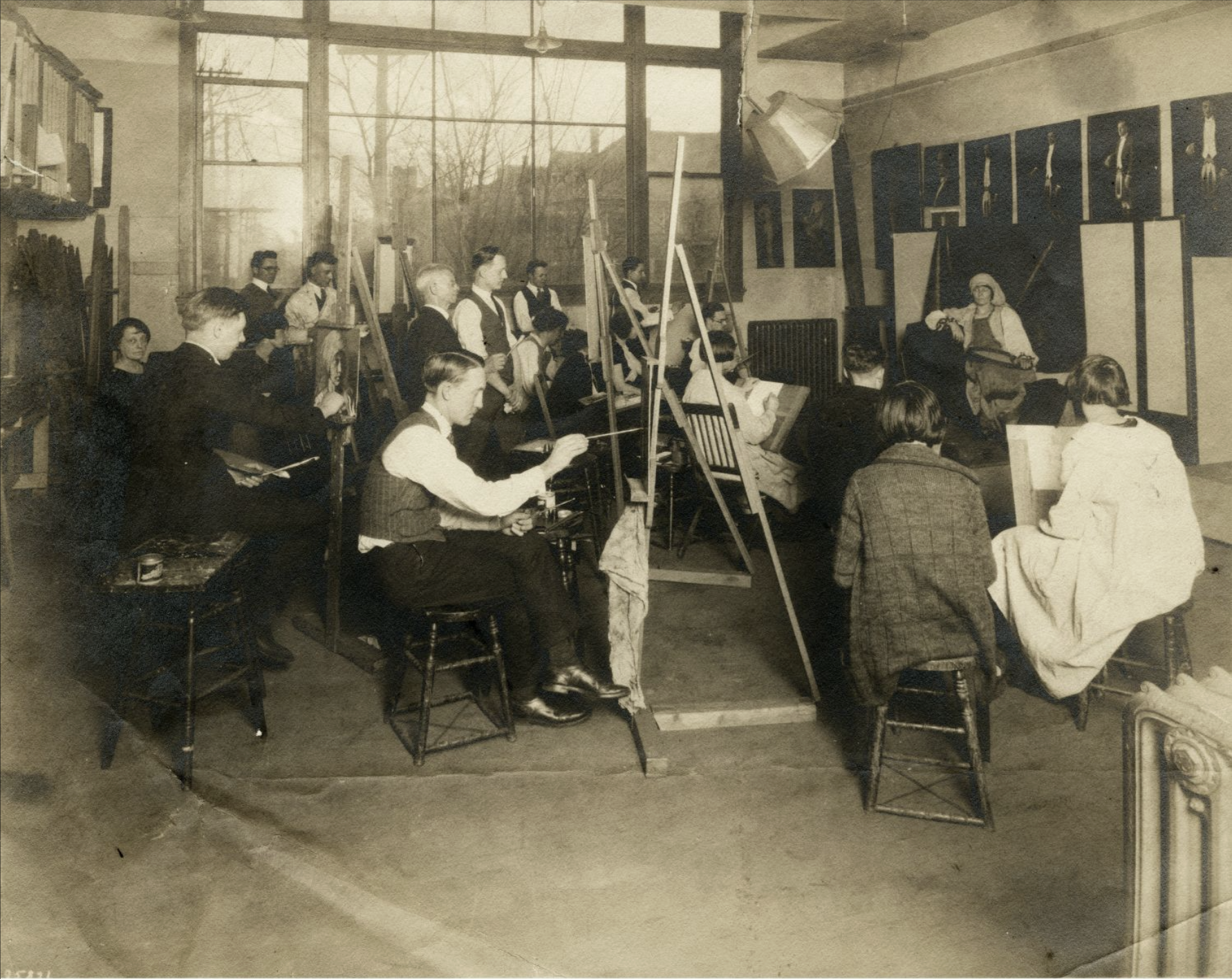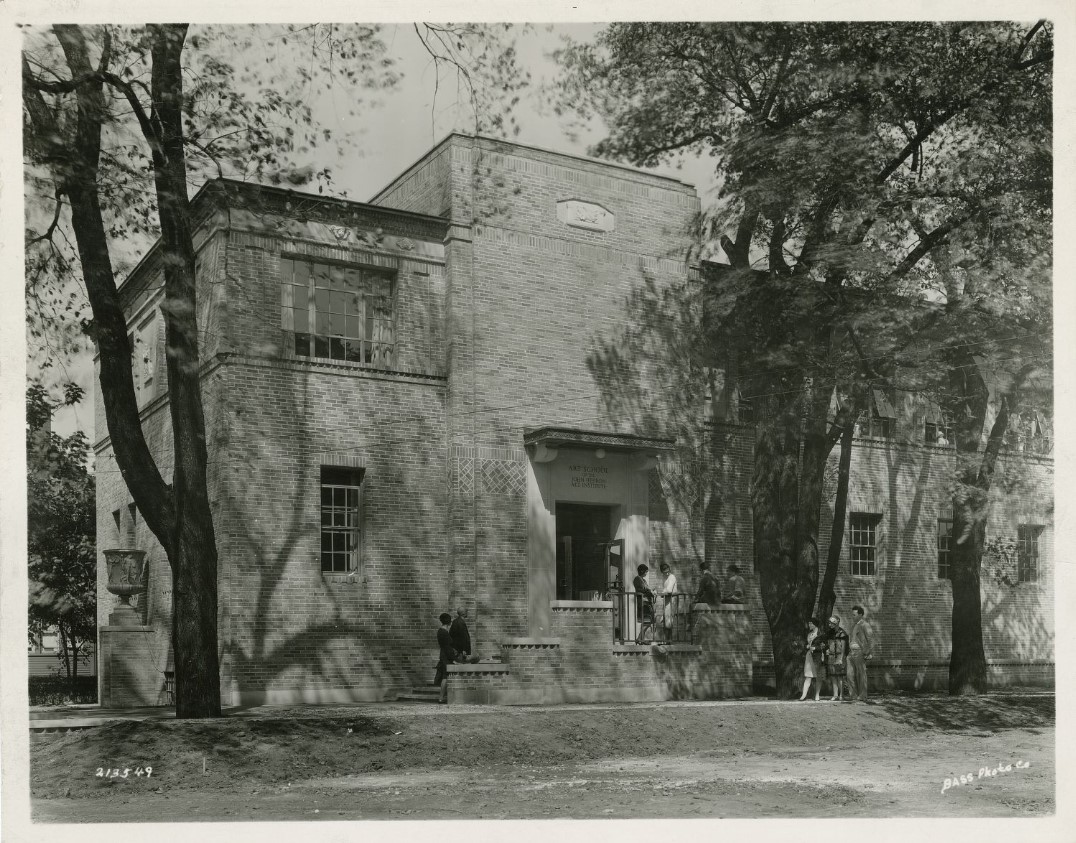Traveling portrait painters may have been the earliest artists in Indianapolis. Portraiture was the only way to maintain the memory of oneself and others until the invention of the daguerreotype in 1832. One such portrait painter was R. Terrell, who informed Indianapolis residents of his availability to paint portraits to encourage the fine arts.

Later artists included , who opened a studio in a room on Washington Street in 1844. opened an art studio in the same building as Cox in 1858. Both men took students. Cox’s pupils included Joseph O. Eaton, Lottie Guffin, John H. Niemeyer, Indiana Underhill Kirkland, Margaret Rudisill, and James F. Harris. Hays’ distinction was as the first mentor of and . Other artists who worked in pioneer Indianapolis included commercial artist James Bolivar Dunlop; Thomas B. Glessing, a scenic artist at the Metropolitan Theatre; John Gibson Dunn; John B. Hill; Elizabeth Nicholson; and James M. Dennis.
The question of forming an Academy of Arts for Indianapolis circulated among Indianapolis’ wealthy citizens as early as 1853. These talks led to the establishment of the Indianapolis Art Society to encourage local artists in their work in 1856. Prior to the establishment of the Society, local artists leaned toward primitive art expression.
It was not until after the centennial exposition at Philadelphia in 1876 that more people in America took note of the importance of art as a cultural expression of American identity. This exposition celebrated the latest advancements in science and technology, generated interest in the decorative arts, and revived interest in the arts and crafts of colonial America. Many American artists moved to Europe after 1876, where they trained to paint in innovative ways. The artists brought these techniques back to America upon their return. James Farrington Gookins, of Terre Haute, Indiana, and John Washington Love, of Indianapolis, were two such artists.
Gookins and Love established the Indiana School of Art, Indianapolis’ first art school on October 15, 1877. Well-known artists of the time, both men instructed classes in drawing and painting. Other instructors included Ferdinand Mersmann, H. C. Chandler, and John H. Warder. At the same time, Hoosier artists Dewey Bates and organized an art association with Bates serving as president and Steele as secretary.

The art school sat at the southwest corner of Washington and Pennsylvania streets in the Fletcher and Sharpe Building, later known as the Saks Building. The school occupied 11 rooms on the building’s top floor. Students and professors organized frequent exhibitions of their work along with masterworks imported from Europe.
At its onset, the school thrived, with 50 students during its first year. The school’s most notable students included William Forsyth, Susan Merrill Ketcham, and Charles Joseph Fiscus. However, the Panic of 1873 led to financial instability for many of the city’s art patrons, causing a decrease in their support. Gookins resigned after the first year, leaving Love, an inexperienced businessman, to operate the school. Financial difficulties led to the closure of the school and the art association in 1879. Though a few independent art schools opened after the Indiana Art School’s demise, none proved successful.
Interest in art revived when a group of prominent residents incorporated a new with 58 members on October 11, 1883. It aimed to cultivate and advance all forms of art, provide for the instruction of those various forms of art, establish a permanent gallery for the display of art, and promote lectures on topics relevant to art.
To achieve its first objective, the Art Association staged the first of two exhibits as a means of cultivating an interest in art for a broader group of Indianapolis citizens. Sue Ketcham traveled to New York City, where she procured 453 pieces of art that formed an “art loan exhibit” at the English Hotel from November 9-25, 1883. The exhibit led to an increase in the Art Association’s membership to 115 members by January 1, 1884.

The group met its second objective with the establishment of an art school, which opened on January 10, 1884. The school, housed in a room at the , began with 30 students. Renowned artist Charles F. McDonald of the Chicago Art League taught drawing classes the last 3 days of the week, and Sue Ketcham led china painting (the decorative painting of glazed porcelain plates, bowls, vases, or statues) classes the first 3 days of the week.
After making a meager yet sufficient profit to warrant keeping the school open a second term, the association moved the school into English Hall, located in the former at Meridian and Circle Streets. T. C. Steele joined the school as an instructor shortly after returning from his studies in Munich in September 1884. After Steele’s return, the Art Association staged its second art exhibit in 1885. This exhibit displayed the work of Indiana’s artists, namely T. C. Steele and William Forsyth. A local group of amateur artists dubbed the Bohe Club came onto the scene by illustrating the program for the exhibit. Despite the success of achieving its first two objectives, waning financial support and the loss of McDonald, who moved to New York, led to the school’s closure in 1886.

In October 1889, T. C. Steele and William Forsyth opened a third iteration of an Indiana School of Art. Originally located in Hartford Block at 84 E. Market Street (now 148 E. Market), the artists established a permanent headquarters for the school in Circle Hall, the former home of .
In 1891, Carl H. Lieber floated the idea of establishing an art school. Learning from the failure of the previous art schools, Lieber, along with several other members from the Art Association, established a fund to maintain a permanent art school under the guidance of Steele and Forsyth. This fund enabled the school to continue with much success. Aside from Steele and Forsyth, other instructors included Mary Y. Robinson, Tempe Tice, and Lydia Becker. The planned expansion of the forced the school to move. Steele offered to move the school to his own residence at 16th and Pennsylvania Streets, known as Talbott Place.

However, in 1895, a large and unexpected gift from the estate of John Herron to the Art Association enabled its members to establish an art museum and art school. In compliance with conditions imposed in Herron’s will, the Art Association established an art school in T. C. Steele’s former studio at the back of Talbott Place.
The school opened as the John Herron Art Institute on January 13, 1902, with 10 students and 5 teachers. Within a few months, the school touted an enrollment of 69 students. taught drawing and painting; and Alfred B. Lyon instructed courses in applied design; and Virginia Keep and Helen McKay taught children’s classes.

Since its inception, the John Herron School of Art, today known as the , has established itself as a leading institute in art education. When the Art Association of Indianapolis board of directors decided to separate the art school from the art museum in 1966, negotiations took place that led to the school’s acquisition by Indiana University in 1967. In 2005, it moved from its original campus at Pennsylvania and 16th streets to Eskenazi Hall on the IUPUI (now Indiana University-Indianapolis) campus. The 169,000-square-foot facility serves as an enduring testament to the work of early Indianapolis art enthusiasts who envisioned a place where people in Indianapolis could experience and create art in its many forms.

Help improve this entry
Contribute information, offer corrections, suggest images.
You can also recommend new entries related to this topic.